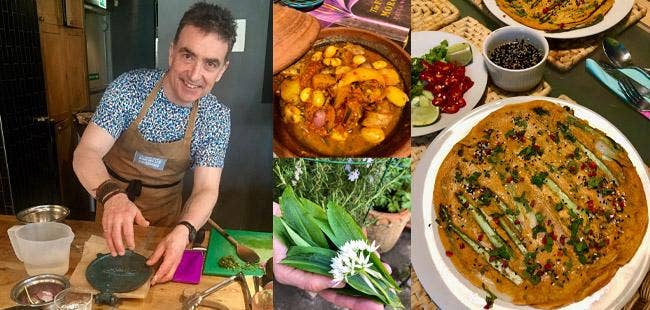We live in interesting times…
The strangeness of our current situation is manifesting itself in many ways and the fact I am here writing about cooking, rather than fishing, is yet another twist I would not have anticipated eight weeks ago. But we are where we are.Ian the cook
Unlike Annie, I am not a MasterChef–standard cook but cooking is a passion that, for me, is all about the craft, not just the end result. I love food, I love to feed friends, but most of all I love the entire process, from recipe planning and preparation to presentation and ultimate enjoyment.Like many born to parents who were ‘basic‘ (boring!) cooks, I learned to cater creatively for myself while at uni, but my culinary journey really accelerated during the years I spent fishing in India and south east Asia and, via my holiday travels, through North Africa and the Middle East, especially Morocco, Lebanon and Palestine.
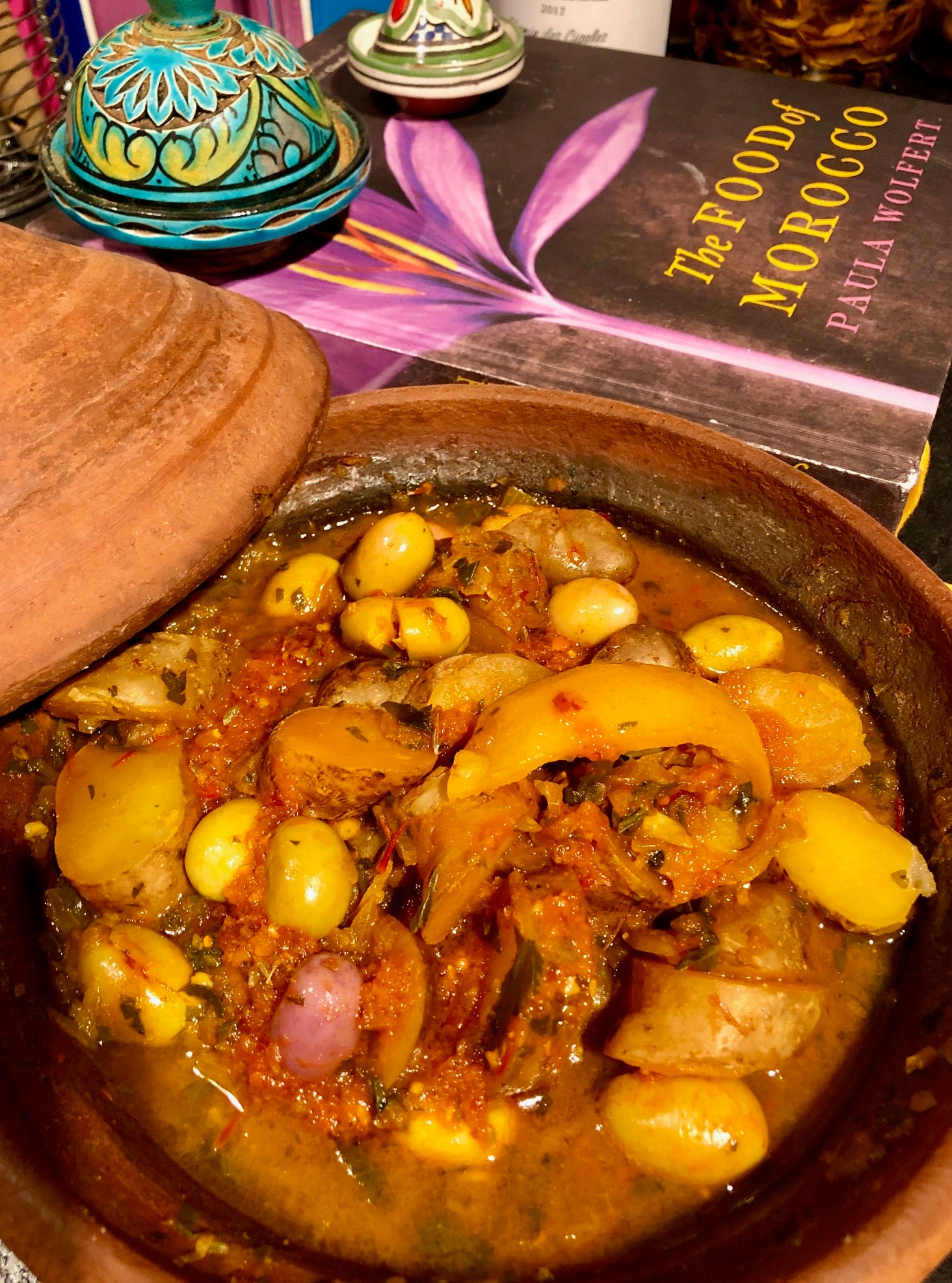 You certainly won‘t find a microwave, lots of tagines though!
You certainly won‘t find a microwave, lots of tagines though!A little bit left field…
You may have already suspected, but before we go any further I should perhaps warn you that as a cook I am a bit ‘left field‘. I cook from scratch every day and have never eaten a ready meal or bought a loaf of bread (why would you, when baking bread is SO easy and the end result so much tastier!) and you certainly won‘t find a microwave in my kitchen! On the tortilla press...
On the tortilla press...You will, however, find mortars and pestles, a puttu maker, idli plates, a taco press, a stovetop smoker, tadkha pans, a dehydrator and various woks, tagines and tangias. And, much to my son‘s disgust, store cupboard staples are not ketchup, beans and biscuits but tahini, pomegranate molasses, za‘atar, belachan, preserved lemons and 101 different dried beans, grains and pulses. I also grow most of my own fruit and vegetables and, as such, nearly always eat seasonally – which is where I start today with this lockdown cookery blog.
Global eating
Being able to eat what we want, whenever we want, quickly became the norm in a global economy with the development of cheap, quick and efficient methods of harvesting, refrigeration and transportation of all food types. Strawberries in December, sure! Green beans from South America, why not! Air miles and climate crisis aside – don‘t panic, I‘m not going to do a Greta Thunberg on you – a real disconnect has appeared between field and plate and many of us have lost our understanding of what food we produce and how, when and where we produce it.The COVID–19 pandemic has forced us all to re–evaluate many aspects of our lives and to make the adjustments required to protect ourselves, our friends and family, our colleagues and our NHS. Many have also, for the first time, been confronted with food shortages and a genuine concern about the safety of going out to shop, if indeed we are fortunate enough to be able to do so.
We now have more time to cook, but less ingredients to cook with. We cannot go out to eat at a favourite restaurant and are delving into the backs of our cupboards and the bottoms of our freezers and making do with what we can find on our infrequent sojourns to shop or market. As a consequence we now beginning to focus more on food and there is a sense of a beginning of reconnection and a realisation that we can create great and nutritional meals from basic ingredients with what we have available. It‘s a real shame we can‘t currently share the joy of eating them with friends and some family members. That will change, but I hope our reconnection with cooking won‘t!
Annie started our lockdown cookery series looking at rhubarb, an ingredient that is in season and which many of us have growing at home. I‘m continuing with two similarly seasonal and readily available local ingredients, wild garlic and asparagus
Wild Garlic
A relative of the onion, wild garlic is easily identified by its distinctively pungent garlic smell, long pointed leaves and white flowers and it is currently blooming in abundance throughout the UK. If you don‘t have clump in your garden it is easy to spot and to forage on your daily walk, avoid older plants with a sea of white flowers and select those with vibrant bright green leaves. I would also swerve those clumps close to footpaths on busy dog walking routes…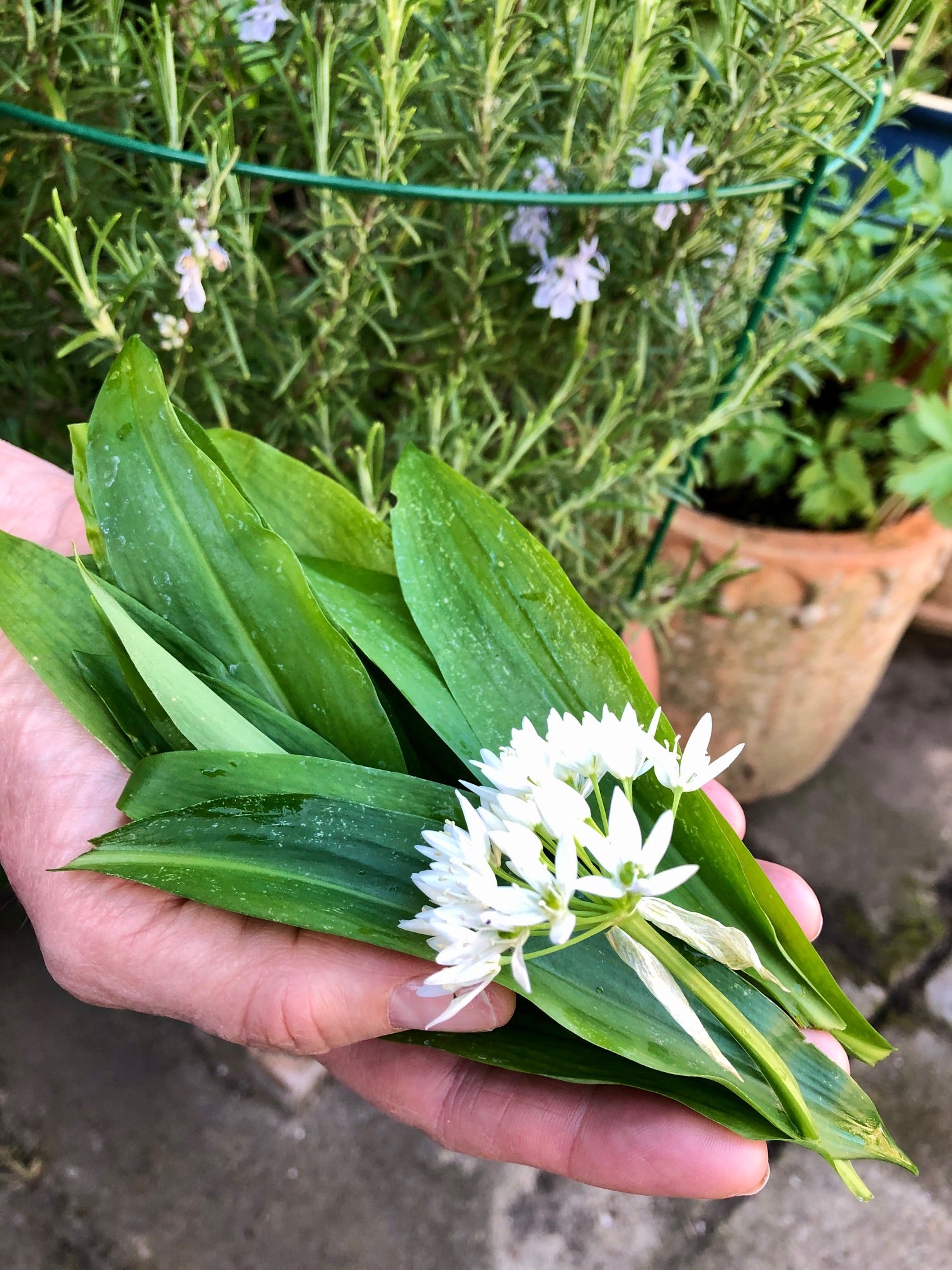 Wild garlic, freshly picked from the herb garden.
Wild garlic, freshly picked from the herb garden.Wild garlic does not require cooking, just wash it thoroughly in cold water and give it a whizz in a salad spinner before eating. Use it whole in salads for a really distinctive, punchy kick or chop the leaves finely and use them exactly as you would any herb to give a beautifully fragrant twang to sauces and dressings.
Cooking really mellows the flavour, all you need to do is wilt it for a minute, in much the same way as you would a bunch of spinach, and stir it through your chosen recipe. I love it mixed through cooked chard or cabbage and drizzled with sea salt and a delicate olive oil as a side, or tumbled through a buttery pan of new potatoes. It is also great shredded raw and mashed into soft butter as a zingy alternative to the usual garlic butter and I love to work a handful of chopped leaves into flatbreads, chapattis and soda bread too, but my real favourite is to make wild garlic pesto.
Wild Garlic Pesto
Making wild garlic pesto is simplicity itself, just blitz a handful of leaves with toasted pine nuts, Parmesan and enough olive oil to bring it together to the consistency you require. For a twist, swap the pine nuts for walnuts or pumpkin seeds, or the olive oil for rapeseed. Perhaps leave out the Parmesan and add a pinch of chilli flakes or add a tablespoon of lemon juice.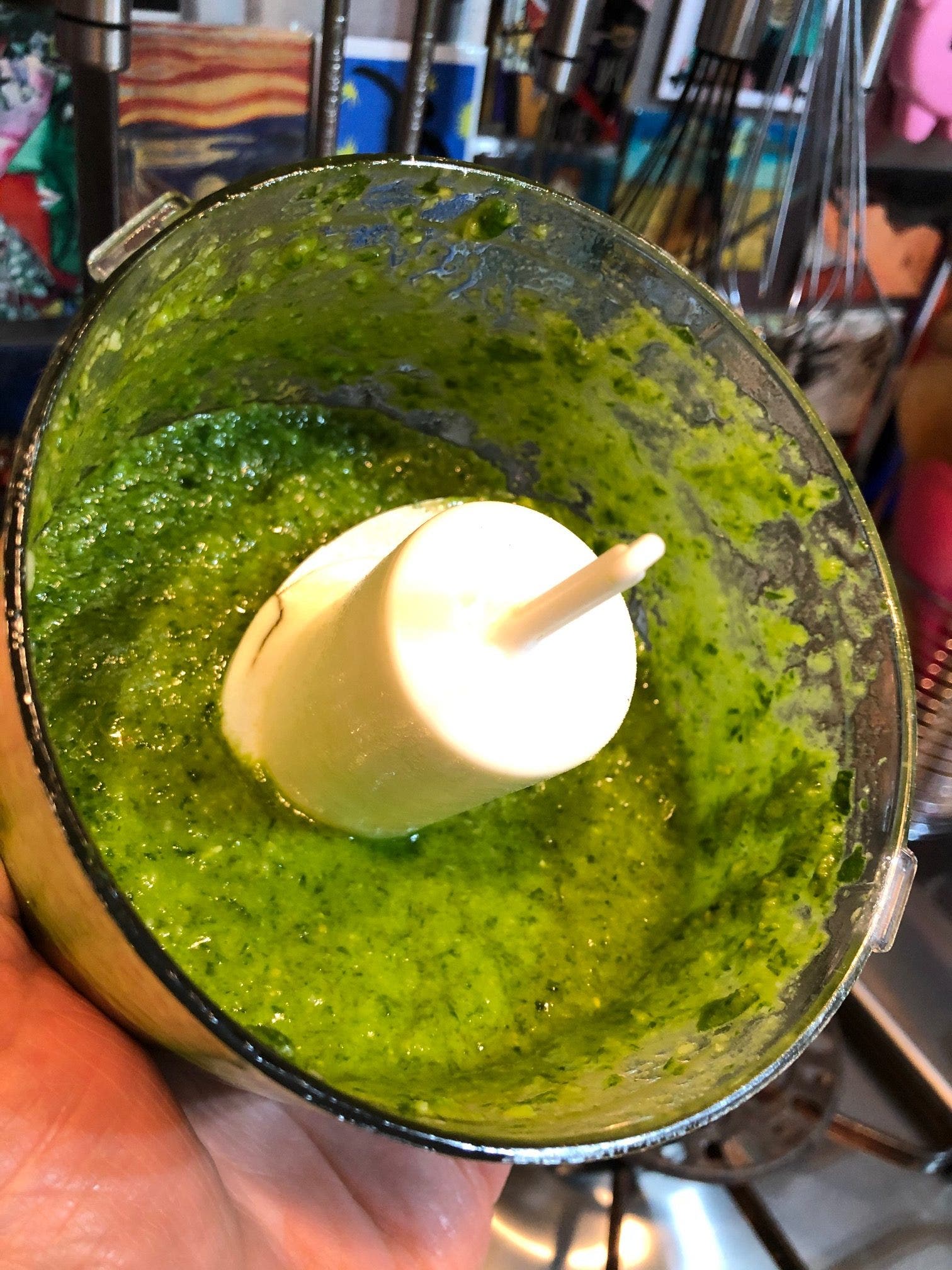 Wild garlic pesto.
Wild garlic pesto.Then again, why not chuck in a few salty, canned anchovies, a couple of tablespoons of capers, a drizzle of white wine vinegar and a hit of olive oil to shake up a traditional salsa verde recipe. Basically mix and match for the dish you are looking to create and stir the finished pesto through pasta, use it instead of tomato sauce on a pizza base, drizzle it over potatoes, roast veg or grilled fish – or simply spread it on crusty bread or toast and tuck in.
The finished fresh pesto keeps in the fridge for approximately a week but I freeze it in portion–sized Tupperware pots and it lasts all year.
Last week I made a simple lockdown supper by spreading some freshly made wild garlic pesto thickly over a sheet of readymade puff pastry (I make my own bread, but life is too short to make your own puff pastry!) and topped it with some freshly picked asparagus, my second featured ingredient in this blog. Served with a green salad and a chilled Sicilian Greciano, it was marvellous.
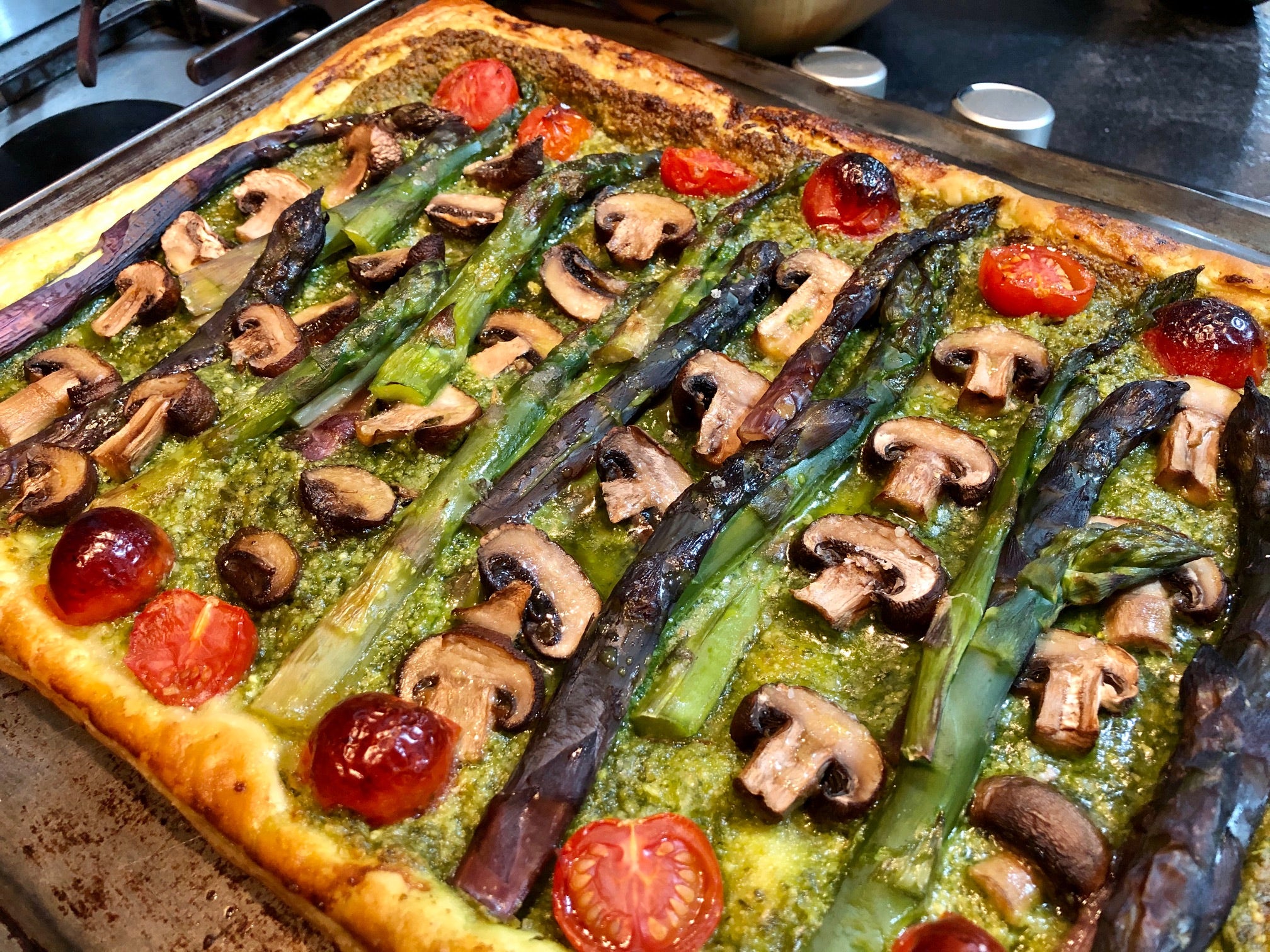 Asparagus and wild garlic tart.
Asparagus and wild garlic tart.Asparagus
Yes, it is now available year round but for the very best tasting asparagus you will never beat locally–grown British spears, preferably cut during the traditional season from St. George‘s Day through to the longest day on 21st June.I grow my own and it was emerging from very warm soil so quickly last month that I must admit I did start cutting a week early (don‘t tell the asparagus police) and I‘m currently harvesting about a kilo a week but British ‘grass‘ is currently abundant countrywide and, despite the threat of a shortage of pickers, seems to be hitting the stores and markets in quantity.
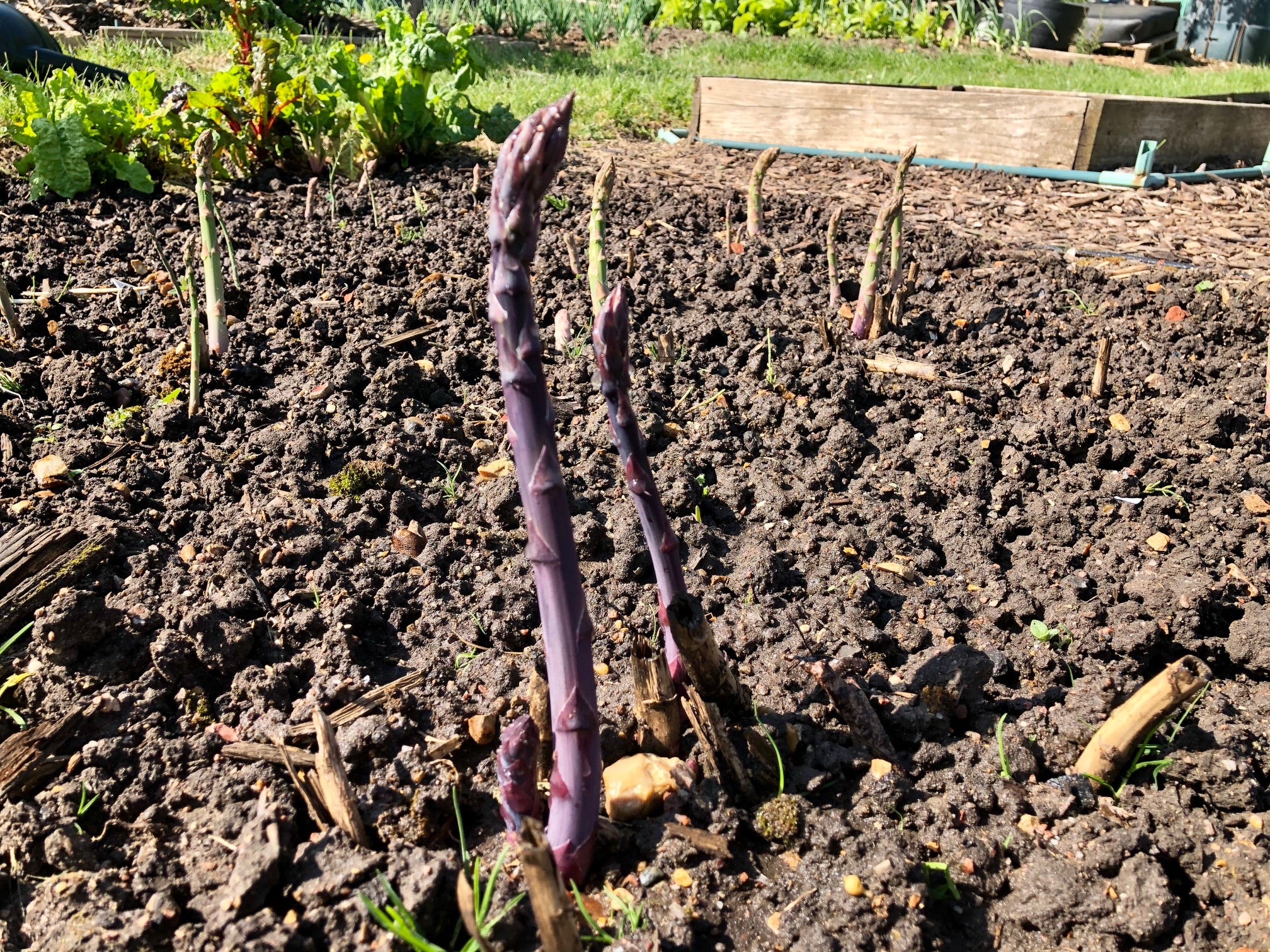 Don‘t tell the asparagus police!
Don‘t tell the asparagus police!There is a lot of rubbish written about asparagus, a lot of myth and mumbo jumbo, and some cooks are just overly fussy – no, you do not need to cook it briefly and make a perfect Hollandaise to enjoy it at its best!
There are just so many Asparagus recipes out there that I am not going to attempt to enter the fray with more, but I will flag up a few favourites and make the point, along with one of my food heroes, Nigel Slater, that everyone undercooks it. Yes, most vegetables benefit from being al dente but to get the full flavour from asparagus you need to cook it properly and, for once, that means floppy is better than stiff…
Griddled Asparagus
As far as cooking is concerned, simple is often best, and my go–to lunch is to brush a handful of spears with a smear of extra virgin olive oil and char grill it on a heavy, ridged pan on a high heat on the stove, turning regularly until it is soft and thoroughly charred. This enhances the nutty flavour and, dressed with a little rapeseed or good quality olive oil, a pinch of chilli flakes, a spritz of lemon juice and a large hit of flaked sea salt, it is a real treat. Pile it high on sourdough toast and, for a serious brunch, top it with a poached egg!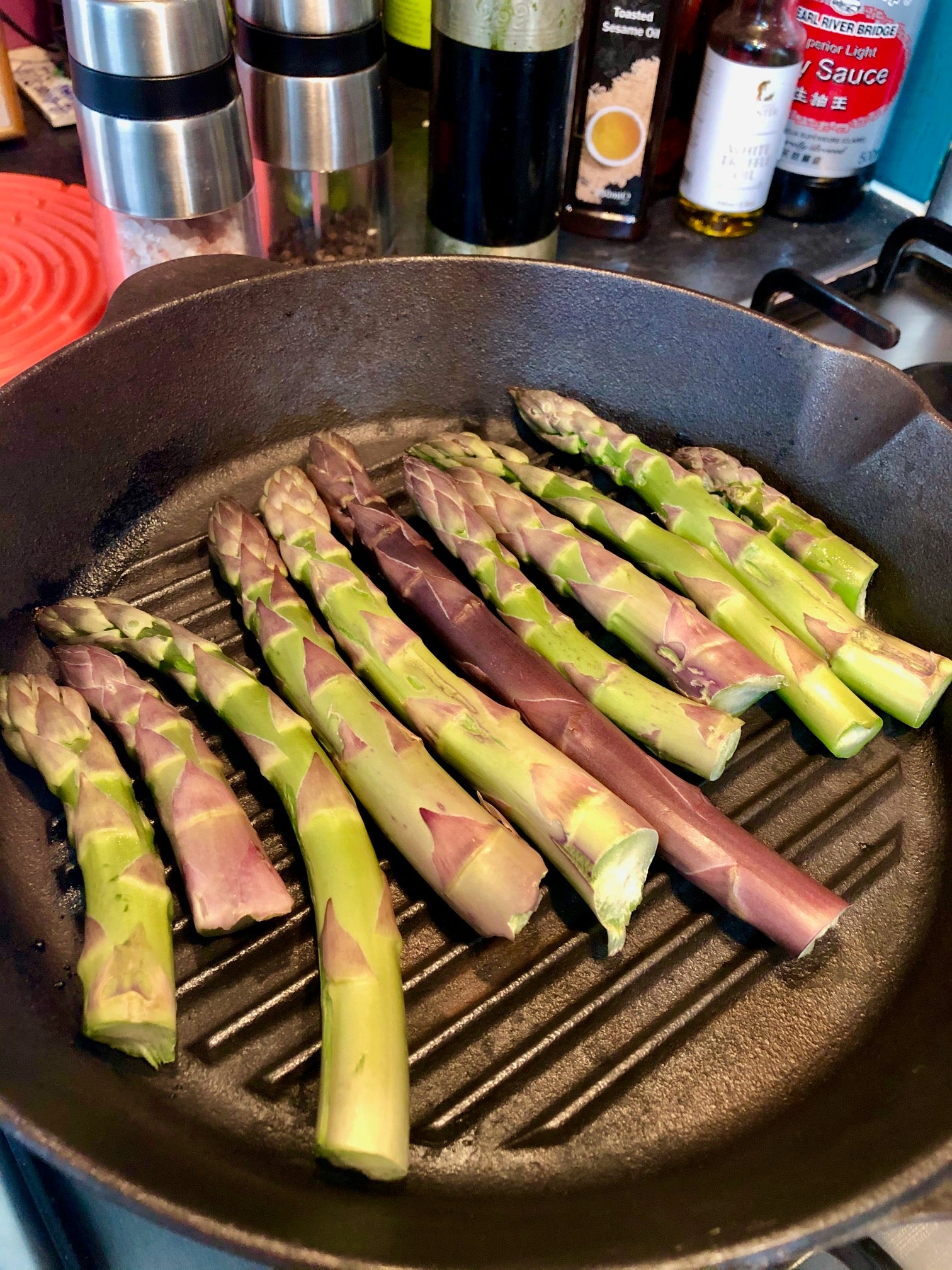 In the griddle pan...
In the griddle pan...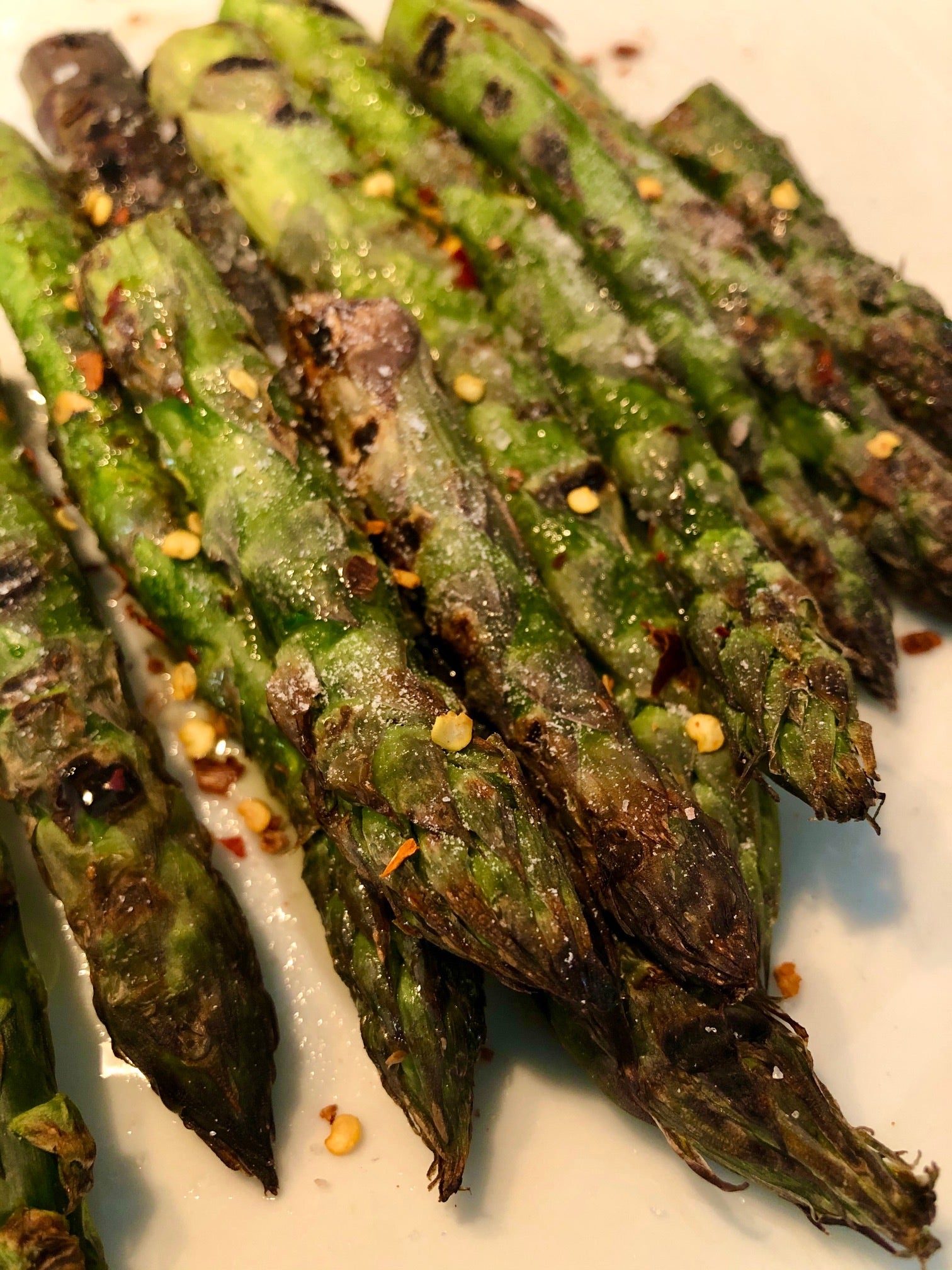 Beautifully charred and served with oil, salt, chilli and lemon.
Beautifully charred and served with oil, salt, chilli and lemon.Roasted Asparagus
Next up for me is a variant of an old Jamie Oliver recipe, and pukka it is too! Chuck a large handful of spears into a roasting tray, add a large handful of cherry tomatoes and another of black olives. Grate a clove or two of garlic in the pan, add a handful of basil leaves, a pinch of red chilli flakes and a bit hit of seasoning. Shake it about with a big glug of quality olive oil then bake it in a pre–heated, hot (200C) oven for about 15 minutes, until the spears are well cooked and the tomatoes beginning to colour and burst. Shave some Parmesan over the top when you take it out and serve with lots of fresh, crusty bread to mop up those sweet juices.Ottolenghi, who else?
In my opinion, the very best recipe to try is Yotam Ottolenghi‘s asparagus and gochujang pancakes. The intense flavour of the gochujang (a fermented Korean chilli paste, available in supermarkets and unlikely to sell out!) does amazing things to both pancakes and asparagus, and as Ottolenghi says, ‘the combination of all three gives you something truly marvellous.‘ My adaptation of this modern classic is below.Ottolenghi‘s Recipe for Asparagus and Gochujang Pancakes
(Makes 4 pancakes and serves 2) Ingredients 140g plain flour 60g rice flour Sea salt 1 large egg 325ml cold water 2 Tbsp gochujang chilli paste 1 Tbsp coriander leaves, roughly chopped, plus extra to serve ½ red chilli, finely chopped (keep the seeds in if you like it hot, otherwise discard) 400g asparagus spears, trimmed and halved lengthways 6 spring onions, trimmed, cut in half widthways and then again lengthways Olive or rapeseed oil to cookFor the dipping sauce 50ml light soy sauce 1Tbsp runny honey 2 tsp sesame seeds, toasted 2 tsp rice-wine vinegar 1 garlic clove, peeled and grated ½ small red chilli, finely chopped
Method For the dipping sauce, whisk together all ingredients in a small bowl and set aside.
Put the flours in a large bowl with half a teaspoon of salt, and mix to combine. In a separate bowl, lightly whisk the egg, water, gochujang, coriander and chilli, then slowly pour in the wet ingredients and whisk gently until it is just combined.
Pour a little oil into a medium–sized non–stick pan on a medium flame. Once it‘s hot, add a quarter of the asparagus and a pinch of salt, and cook for a couple of minutes, turning a frequently, until it begins to soften and colour.
Add a quarter of the spring onions, cook for 30 seconds more, then pour over roughly a quarter of the batter and swirl it around so it spreads out to cover the entire surface area of the pan.
Leave the pancake to cook for two to three minutes, then flip over and cook for the same time on the other side until it is crisp and golden.
Transfer to a plate, keep warm and repeat with the rest of the oil, asparagus, spring onions and batter, making four pancakes in all.
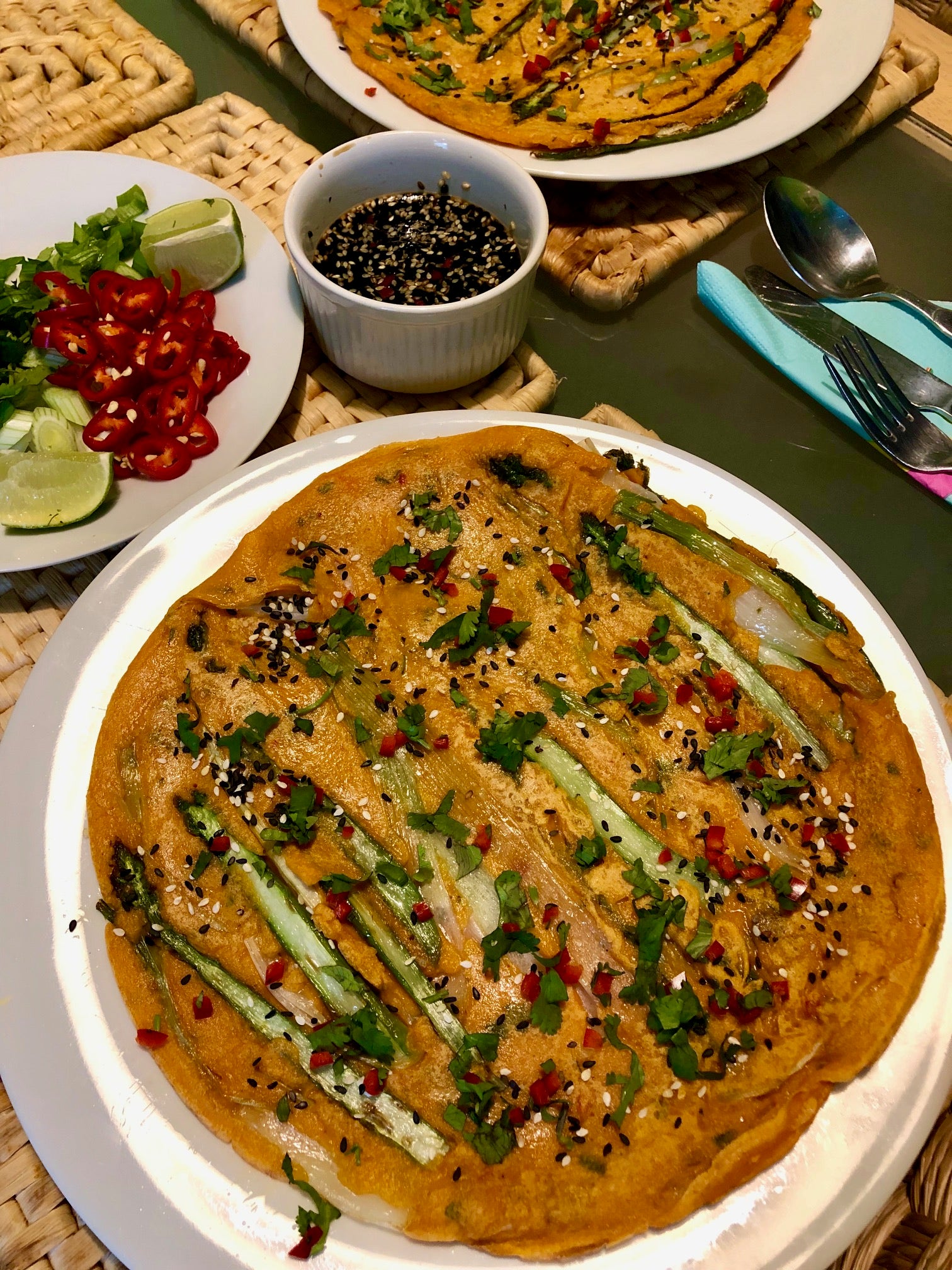 Ottolenghi‘s gochujang pancakes, a perfect way to use the new season asparagus.
Ottolenghi‘s gochujang pancakes, a perfect way to use the new season asparagus.To finish off, sprinkle over the remaining coriander and serve the sauce alongside or drizzled over on top
That‘s it for me.
Stay safe, keep cooking and if, after this, they decide to let me back I‘ll rustle up an easy–peasy loaf that anyone can bake and I‘ll help you to up your game in the great banana loaf challenge that seems to be becoming a lockdown special.


